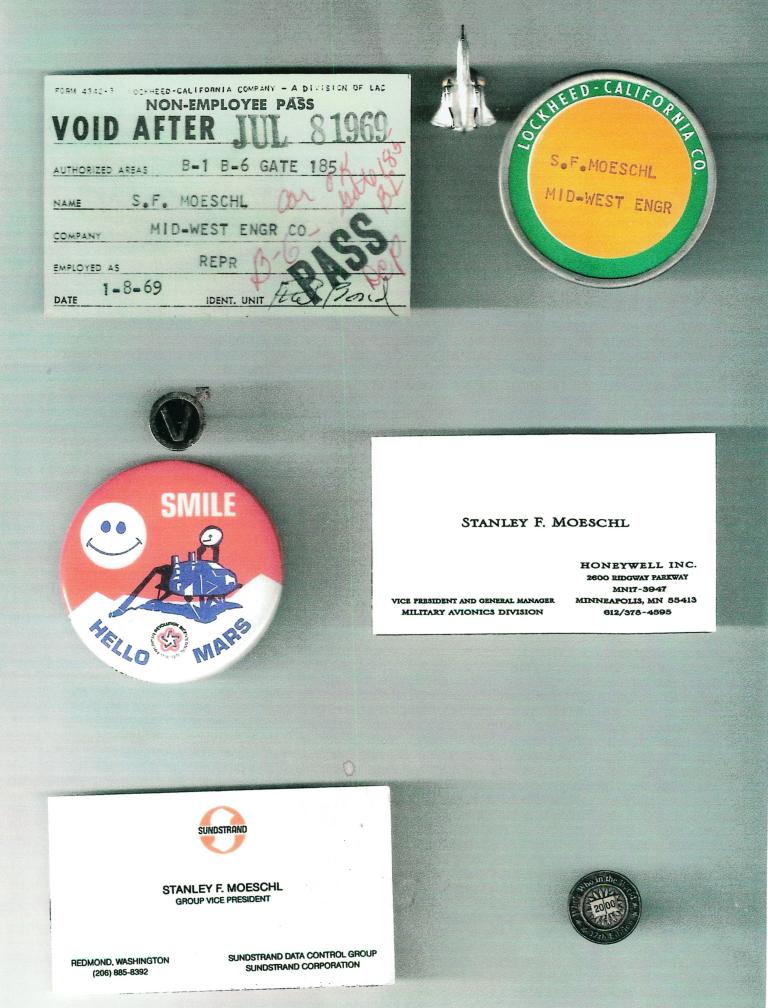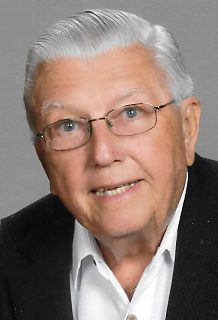


 |
 |
 |

ROADRUNNER LIFE MEMBER
I returned to the U.S., after serving 13 months in the Korean war zone in early 1954. In September, 1954 I married my high school sweetheart, got discharged from the service, and began studying Electrical Engineering at Purdue University, all in a two week time frame.
I graduated from Purdue in June, 1957 and began my career at Honeywell, St. Petersburg, FL; new inertial navigation center in July, 1957. My Oxcart adventure began in late 1959. Two engineers from Lockheed visited our facility and were very interested in Honeywell's digital inertial navigation system which we were developing on our IR&D funds. They wanted to know the weight, volume, accuracy and cost of the system. They also asked when it would be ready to fly. We provided them all the data they had requested.
About a month later we had a call from Washington, D.C. asking if we could meet with some engineers and managers at a fish market on the Potomac. Myself and Gill Faulk met with four individuals from the CIA for an afternoon. At the end of the meeting they asked if we could be ready to fly by 1962 and could we meet a navigation error rate of one nautical mile per hour? Our answer was yes to both. They instructed us to open a post office box in Largo, FL in the name of Midwest Engineering and we would receive further instructions.
Thus began ten years of being a Spook on the most exciting, satisfying time any young engineer could experience. In early 1962 we were ready to fly but the A11 wasn't quite ready. Five Honeywell engineers proceeded to Los Angeles for six month with our families and were scheduled to begin flight testing in a Lockheed Jet Star. My family and I moved into a rental house in Sherman Oaks. Before we could get the INS installed in the Jet Star it crash landed in a grassy field in the San Fernando Valley.
Our next flight test vehicle was a U-2 piloted by Francis Gary Powers. Powers was a workaholic taxiing up and down the runway at Burbank and flying Burbank to Seattle and back twice a week. We discovered a major problem with the system which was confirmed at the Honeywell facility in Florida. The five engineers returned to Florida for six weeks, leaving our families in L.A. This was not an easy time on the families, as they had no idea what we were doing.
We returned to L.A. with a fix in the system and continued our flight testing in the U-2. At the completion of flight testing at Burbank four of the engineers began their weekly sojourn to area 51 to set up the INS lab. I stayed in Burbank and was the Midwest Engineering rep at the Skunk Works in Burbank.
While at the Skunk Works almost every week a Lockheed engineer would come up to my desk and say, "What if?". What if we wanted to get off the ground in 60 seconds rather than spending an hour calibrating the system prior to flight? What kind of air rate could you guarantee under these conditions? Several months of testing in Florida confirmed a SMIT system could guarantee three nautical miles per hour error rate in sixty seconds if we knew the runway heading the pilot would use for takeoff. This system was installed in the YF-12 and flight tested at Edwards Air Force Base.
Then there was a day Hugh Stocker, a Lockheed engineer said, "What if?". What if we had a drone that would piggy back on the back of the A-11? Could we update the drone system from the A-11 system prior to launch? This led to the MD-21, better known as Tagboard. It was during this timeframe, late 1962, I walked into Kelly Johnson's office one morning, introduced myself, and told him I was having a bit of trouble understanding the Skunk Works organization. When someone asked me a "What if" question I really did not know who was asking and how I should respond. Kelly went to the blackboard and drew the following org chart.
|KJ|
_____________________________|____________________________
| | | | | | | | | | | | | | | | | | | | | | | | | | |
He said KJ, that's me, and all the people who work here work for me. I said thank you and politely left his office.
In 1963 I too was taking the Lockheed Connie to Area 51 on a weekly basis. By 1964 I was cleared on Oxcart, Kedlock, and Tagboard. Also in 1964 we began meeting with mission planners at Langley and the Pentagon helping with mission planning software.
By early 1966 we received two surprises. First, there was talk of taking the A-11 to Kadena for Black Shield. Our system was a relocated pole system, i.e., our pole was located on the equator in the Pacific, rather than the North Pole. If we were going to fly across the Pacific we had a major software change to put the pole back at the North Pole. Which we did prior to relocating to Kadena.
The second was much more traumatic. When on the fourth MD-21 flight test the two vehicles collided and we lost Ray Torick. Kelly Johnson canceled the program but the Air Force decided to launch the drone from under a B-52 wing. They attached a rocket under the drone to propel it from 40,000 feet to 80,000 feet where the drone Ram Jet Engine took over propulsion. Since the drone was ferried for hours on the B-52, Honeywell developed a star tracker so the drone could be updated to better the .25 miles at launch. We worked with Art Bradley and the Air Force on a program known as Senior Bowl.
In 1968 the Air Force canceled the YF-12 program, the White House ended the Oxcart program and the Tagboard program ended in 1971.
I left the Spook world in 1970, returned to Florida and became Honeywell's Program Manager on NASA's Viking Lander Program which landed two spacecraft on Mars in 1976.
In 1982 I became VP and General Manager of Honeywell's Military Avionics Division. After 31 years at Honeywell I retired in 1988 and became Group VP for Sundstrand in Redmond, WA.
I retired from Sundstrand in 1992 and now split my time between Florida and Minnesota. I still think of my time as a Spook from 1959 to 1970 as the most interesting, exciting time in my career.
I have been listed in Who's Who in Engineering for 13 years and Who's Who in the World for the last 10 years. Attached is a page depicting my career spanning from 1957 to 2000. Two thousand and nine will be my first Roadrunner reunion. I am looking forward to meeting some of the people I worked with in the 60's.
IN GOD WE TRUST - ALL OTHERS WE MONITOR

 Moeschl, Stanley Francis, age 89, passed away unexpectedly on May 7th from complications of heart failure. Stanley was preceded in death by his parents Stanley and Mathilda Moeschl, and brother Ralph (Ruby) Moeschl. He is survived by his loving wife, Kathy, and his four children, Stan (Melissa) Moeschl, Melissa (Tom) Carroll, Deb (John) Clancy, and Karen (Dave) Torres; 11 grandchildren Joshua, Kevin, Sarah, Kathlyn, Christina, Kate, Erin, Elizabeth, Jake, Emily, Grace; 4 great-grandchildren, Zooey, Benjamin, Benjamin, Claire; sisters Ann Richter and Carol (Dick) Linneman, as well as many nieces, nephews, and great friends.
Moeschl, Stanley Francis, age 89, passed away unexpectedly on May 7th from complications of heart failure. Stanley was preceded in death by his parents Stanley and Mathilda Moeschl, and brother Ralph (Ruby) Moeschl. He is survived by his loving wife, Kathy, and his four children, Stan (Melissa) Moeschl, Melissa (Tom) Carroll, Deb (John) Clancy, and Karen (Dave) Torres; 11 grandchildren Joshua, Kevin, Sarah, Kathlyn, Christina, Kate, Erin, Elizabeth, Jake, Emily, Grace; 4 great-grandchildren, Zooey, Benjamin, Benjamin, Claire; sisters Ann Richter and Carol (Dick) Linneman, as well as many nieces, nephews, and great friends.
Stanley was born in Cincinnati, Ohio in 1931. He graduated from Saint Xavier High School in 1949 and entered the Coast Guard, where he served in the Korean War Zone. In September of 1954 he married his high school sweetheart, Kathy, was discharged from the service, and began studying Electrical Engineering at Purdue University, all within a two-week time frame. Stan began his career at Honeywell in 1957. From 1959 to 1970, he worked on top-secret programs with the CIA, the United States Air Force, and Lockheed Skunk Works. He worked on many exciting and satisfying projects, including the A-12 (SR-71 Blackbird) and NASA's Viking Lander spacecraft. Stan managed his fulfilling career while being happily married and raising four children. In 1988 Stan retired from his position as the Vice President and General Manager of Honeywell's Military Avionics Division, and in 1992 retired again as President of Sundstrand Data Control. Since then, Stan and Kathy have divided their time between Fort Myers, Florida and Alexandria, Minnesota.
Stan was a driven and gregarious individual, generous with his time, money, friendship, expertise, and sense of humor. Especially in retirement, he treasured strong relationships with his children, grandchildren, and great-grandchildren. Stan had a talent for creating fun opportunities for his family to spend time together. He and Kathy shared many adventures, traveling the world and visiting family and lifelong friends along the way. Stan will be greatly missed.
Due to Covid-19, a virtual service will be held. For details, please email stanmoeschlmemorial@gmail.com. Those who wish to make a donation in Stan's memory may do so to the Cystic Fibrosis Foundation.
Stanley was a staunch supporter of the Roadrunners Internationale Association of former CIA, Air Force, and contractors participants in the Agency and Air Force Projects OXCART, KEPLOCK, and TAGBOARD at Area 51. Stanley also supported the Nevada Aerospace Hall of Fame originated in 2008 to continue the legacy of the Roadrunners as well as the pioneers who preceeded and continued their accomplishments to advance aviation and aerospace in the state of Nevada.
 |
 |
 |